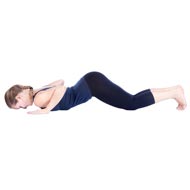- Aromatherapy (36)
- Benefits of Yoga (282)
- Home Remedies (1087)
- massage therapy (9)
- Preventive Therapy (135)
- Running (41)
- Skin Care (15)
- Stress Relief (25)
- Stretching (5)
- walking (33)
- Womens Health (14)
- Yoga Benefits for Pregnant Women (16)
- Yoga Benefits for Students (3)
- Yoga for Children (11)
- Yoga for Holistic Living (37)
- Yoga for Midlife Crisis (3)
- Yoga for Senior Citizens (2)
- Yoga for the Workplace (1)
- Yoga Health Tips (185)
- Yoga Practice during Menstruation (5)
Yoga For Joint & Muscle Problems

Yoga is supposed to heal muscle and joint problems. If you’ve seriously hurt your calf muscles while practicing yoga, then there are chances that you’ve tried complicated postures without guidance; began your session without warming up; pushed yourself too hard to do positions that your body wasn’t yet ready for; or, done some posture incorrectly. While yoga is supposed to be a great form of exercise for overall fitness and well-being, there are certain guidelines that one has to follow to prevent serious injuries. Yoga is actually a science, which needs to be done correctly to enjoy the maximum benefits. If you suffered from musculoskeletal problems before you tried yoga, then again it’s likely to sustain muscle injuries.
Relaxing and soothing, yoga if done incorrectly, can cause harm to muscles and lead to torn ligaments and serious injuries. So, it’s a good idea to do the postures in moderation, and according to your flexibility. If you do so, yoga will increase your balance, strength and suppleness. Yoga can also cure joint and muscle problems like tennis elbow and carpal tunnel syndrome.
Here Are Some Basic Guidelines That You Need To Follow Before Or While Doing Yoga:
- If you suffer from certain injuries or health problems, then it’s advisable to speak to your physician before beginning yoga.
- You also need to find a qualified yoga teacher who can guide your through the right postures. So, do check on his or her credentials and teaching experience.
- Warming up before doing any yoga postures is extremely important because un-stretched muscles, cold ligaments as well as tendons can get harmed very easily.
- You also need to wear loose, comfortable clothing while doing yoga.
- If you are a beginner, then it’s advisable to begin with basic breathing techniques and simple postures before going on to complicated poses. Do not try to stretch too much in your first few yoga classes.
- If you haven’t been able to follow a particular posture or asana, it’s always good to ask the teacher to show the movement to you again.
- You have to know your own limit and should not push yourself to do all the poses that your classmates are doing. Do what your body is comfortable with and give yourself time to learn and become more flexible.
- Keep your body hydrated, so that you don’t feel sick while or after your yoga session.
It’s also advisable to listen to your body. If you feel exhausted or pain in some muscles, stop and speak with the yoga teacher.
- RSS Feeds -
- All posts
- All comments
- Knee Exercises In Yoga The knee joint is a critical joint in the leg. It allows the leg to bend half...
- Sacroiliac joint exercises The sacroiliac joint is the joint that connects the spine and the pelvis. The...
- Multi-Joint Exercises Multi joint exercises for women and men are especially designed to increase the ...
- Yoga for Elbow Dislocation The elbow, called the synovial hinge joint, connects the forearm to the arm. Lik...